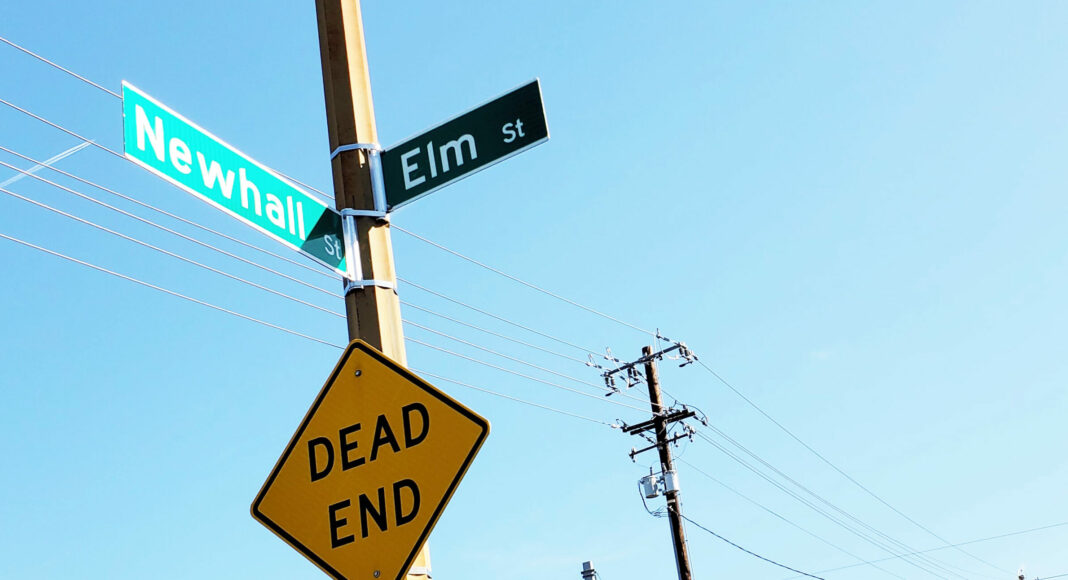Near the Santa Clara Caltrain Station, where Newhall Street dead-ends at the tracks, one can begin a journey through Silicon Valley history all the way to El Palo Alto without leaving the same contiguous city street.
I’m not talking about El Camino. You see, Newhall becomes Scott Boulevard, which becomes Arques Avenue, which veers into Central Expressway, which then barrels right through the apocalyptic concrete chaos of the San Antonio interchange and into Palo Alto, where it becomes Alma Street, a long straight shot all the way to the redwood tree that gave the city its name. There it becomes an onramp to El Camino, right across from Stanford Shopping Center. If one begins this whole expedition at Newhall in San Jose, one does not have to leave the same connected piece of asphalt.
In the process, the journey takes one through the entire mess of Silicon Valley’s past and present, a splendid way to explore how the valley was cobbled together over the decades. You will need a car to do the whole thing in one go.
To begin with, old maps from the ’60s reveal that Newhall once crossed the railroad tracks and went right into the southern edge of the San Jose Airport. Now we have a dead-end. I like it better that way. Dead-ends are great places to start.
From here, one proceeds westward past institutions like Bill’s Cafe and the Normandy House Lounge, the latter of which anchors a classic Santa Clara intersection with two celebrated strip malls kitty-corner from each other. It’s probably only a matter of time before real estate greed wipes it all out.
Newhall then curves its way around the cemetery neighborhood and passes Saratoga, where it turns into Scott Boulevard. From here Scott becomes a northbound street, forever and ever, before it veers left and becomes Arques right at Calabazas Creek. This particular stretch of road, where Santa Clara fades into Sunnyvale, is textbook Silicon Valley: defense contractors, tech companies, research institutes and office parks with wide grassy parking strips. All with Indian fusion restaurants, taquerias and leftover suburban churches wedged in the middle of it all.
Continuing due westward, the original bits of Arques come into view, throwing the traveler back to the glory days when Sunnyvale first morphed from orchards into gritty old-school suburbia, that is, the more interesting flavor of suburbia before the fixed-up suburbia ruined it all. You can still discover pieces of it, especially in the vicinity of Arques and Fair Oaks.
More old street maps from 60 years ago—before Larry and Sergey of Google were even born—reveal that this area was not yet filled in. Arques only existed in pieces. Same with Fair Oaks. Even Central Expressway was still an incomplete project.
The only piece of this journey to which my detractors might object is when westbound Arques slides off into Central Expressway, which might seem enough of an “offramp” to disqualify it from being “one continuous road,” but if you go there, you’ll see. It’s not really a turn-off. It’s the same damn street. Fifteen years ago it was more obvious. This is where Larry and Sergey actually did something useful. You can go back and check the 2008 version of this fork in the road. It’s all there on Google Earth.
At the end of the journey, which I admittedly did in pieces, I arrived at El Palo Alto, the tremendous redwood that gave the city its name, feeling like I had traveled backwards in time. Thinking about the Ohlone who were here first, I looked back the other way, imagining I could see down Alma, to Central Expressway, to Arques, to Scott, to Newhall, and all the way back to the San Jose dead-end where I started. The past merged with the present. Space and time dissolved. There was no end and no beginning. The Ohlone probably knew this.
I could have just taken Caltrain from Santa Clara to Palo Alto—pretty much the same beginning and endpoints—but that’s no fun. What idiot would waste his time that way?
As such, this column felt like travel literature. And writing travel literature makes everyone a better journalist. Who needs freeways for anything?




Great read on history of street.